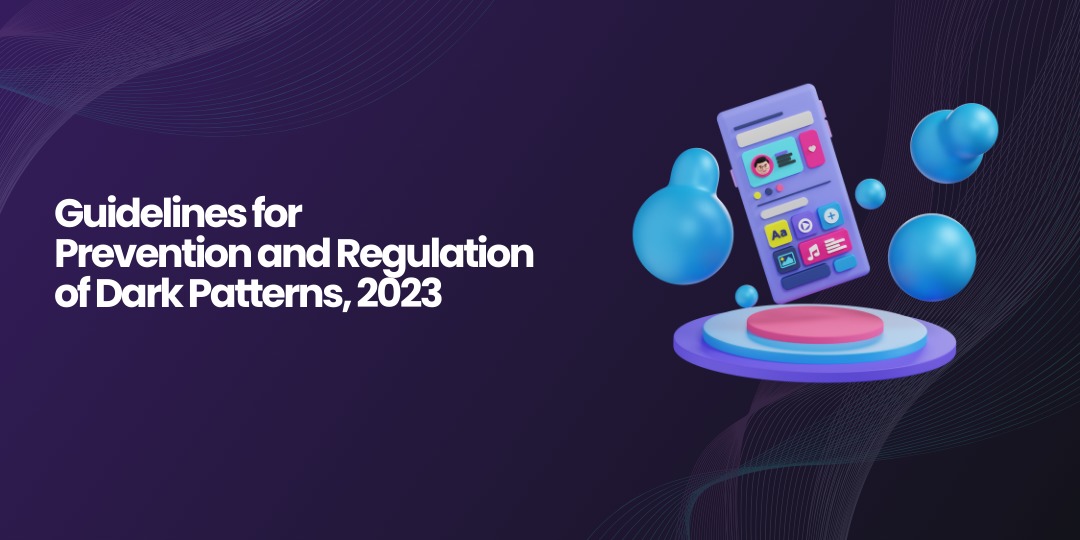A Birds-Eye View on the Guidelines for Prevention and Regulation of Dark Patterns, 2023

Srivatsan S, Associate – Dispute Resolution Practice
E-commerce and Online Shopping pioneered in India as early as in the year 1995. With the advent of the Internet Revolution in the country, auctioning websites such as bazee.com and online only booksellers like amazon.com became popular avenues to indulge in E-commerce. The industry has come a long way since then. The volume, frequency and dependency on such online platforms have increased multifold, consequently, the necessity to protect consumers online has also become inevitable.
The Consumer Protection Act was originally enacted in 1986 and the same was a revolutionary move by the legislature to protect the interests of consumers. The Consumer Protection Act, 2019 which repealed the 1986 Act further brought in necessary changes to make the legislation more holistic and effective. To ensure proper functioning of the Consumer Protection Regime, the legislature of the Country also formulated Rules and regulations.
In its latest effort to fortify Consumers’ interest, the Department of Consumer Affairs shared the draft “Guidelines for Prevention and Regulation of Dark Patterns, 2023” (Hereinafter “Guidelines”) on September 6, 2023. The said Guidelines will be implemented upon notification in the Official Gazette.
WHAT ARE DARK PATTERNS?
Section 2 (1)(e) of the Guidelines defines “Dark patterns”. Dark Patterns are any practices or deceptive design patterns using UI/UX (user interface/user experience) interactions on any platform that are designed to mislead or trick users to do something they originally did not intend or want to do; by subverting or impairing the consumer autonomy, decision making or choice; amounting to misleading advertisement or unfair trade practice or violation of consumer rights.
Further, Annexure I of the Guidelines provides a list of 10 specified Dark Patterns that are sought to be prevented, a few are listed below with examples for illustrative purposes:
- “False Urgency” – Where a platform may send a notification to a user when they are viewing a product, that 35 other users are also looking at the same product, when in fact that is not the case. A false urgency is therefore being created by the platform.
- “Basket sneaking” – Where a platform adds an additional subscription fee for a service to a pre-existing shopping cart for food items, without consent of a user. Products / services, through this Dark Pattern, are snuck into the Shopping cart or basket of an unwitting consumer who may not realise these are not compulsory purchases.
- “Subscription trap” – This is when platforms collect credit card information of users without informing them that there will be an automatic month on month debit of a fixed/variable amount. Further, when the platform makes it impossible or too complex for a user to end a subscription. Many users feel trapped in subscriptions they are unable to get out of or never wished to take on in the first place, due to this Dark Pattern.
- “Nagging” – When online platforms flood a user with unrelated content, notifications, or other messages that it disrupts the use’s whole interaction with the Online platform, it is considered nagging.
- “Confirm Shaming” – When a platform uses phrases to make a user feel guilty, ashamed or ridiculed for not acting in a way the Platform wishes them to act. A platform that adds a subscription to a user’s shopping cart using the phrase “I don’t care for paying for quality journalism” is an example of confirm shaming.
- “Forced action” – Where a Platform offers coupons / offers that can be availed only by paying for an unrelated and unintended product or service.
- “Interface interference” – Using a smaller or lighter font for the option to cancel a subscription or to even completely obscure such an option.
- “Bait and switch” – When the user is lead to believe that a particular product or service is available until the stage of checkout it is considered a ‘Bait’. Thereafter stating that is unavailable and showing an alternate similar product which is more expensive than the first is considered a ‘Switch’.
- “Drip pricing” – Where a platform leads a user to believe that a service is free but thereafter disclosing that continuation of the said service would involve a payment.
- “Disguised advertising” – When a platform shows content as if it has been created by a user but in fact it is an advertisement disguised as a content.
The above list of Specified Dark Patterns is not exhaustive, and the Legislature has the power to include more forms of Dark Patterns to the list if such need arises.
CONTRAVENTION OF THE GUIDELINES
The contravention of any Guidelines, viz., the usage of any of the Specified Dark Patterns, would fall within the ambit of the Consumer Protection Act, 2019 (Hereinafter “The Act”) as per Section 8 of the Guidelines. It is pertinent, at this stage, to note that the institution of a full-fledged Consumer Case before the Consumer Commissions may not be viable for a consumer as far as Dark Patterns are concerned, owing to the necessity for strict timelines and an immediate remedy, rather than a long-drawn Litigation. An aggrieved user/consumer may instead approach a Consumer Authority, such as the Central Consumer Protection Authority for instituting action against an Online Platform using Dark Patterns.
The Central Consumer Protection Authority has been empowered under Chapter III of The Act to do, inter alia, the following:
i. inquire or cause an inquiry or investigation to be made into violations of consumer rights or unfair trade practices
ii. pass an order of discontinuation of practices which are unfair and prejudicial to consumers’ interest.
iii. Issue directions and penalties against false or misleading advertisements.
Considering the above and the fact that the Central Consumer Protection Authority has been specifically defined under Section 2 (1)(c) of the Guidelines, the interpretation that a complaint before such an Authority may be considered by an aggrieved user gains better footing.
IMPLICATIONS OF THE GUIDELINES COMING INTO FORCE
The Guidelines seek to regulate and prevent Dark Patterns from being used by Online Platforms. Online Shopping platforms, ticket booking platforms and other types of E-commerce entities would be directly impacted by the Guidelines. The definition of Dark Patterns and the existing list of Specified Dark patterns showcase the importance that the Legislature has placed on protecting the “interaction” of users on any platform.
ft followed business practice such as the following, inter alia, would have to be revamped by Online Platforms:
a. creation of a false scarcity of products or services claiming that multiple users are looking at the them at any given moment,
b. adding products/services/subscriptions to the online shopping cart without consent of the user,
c. disguised advertisements projecting marketing gimmicks as user created content,
d. the very policy relating to ending subscription plans without hassles.
The users / consumers on the other hand who intend to indulge in transactions online, would enjoy greater autonomy and transparency in their E-commerce transactions.
THE NEED TO CONTROL AND REGULATE DARK PATTERNS
1. DARK PATTERNS AND PERSONALITY RIGHTS INFRINGEMENT
Digital media and electronic means of transacting have permeated every step of the purchase chain, right from product discovery, pricing, trial and actual purchase. E-commerce, as a result, is more frequently used by consumers and is at times preferred over traditional transactions owing to the convenience it inherently possesses. The importance that is given to user autonomy and consumer privacy gave rise to the Guidelines. Unfair Trade Practices in traditional transactions is covered by the Consumer Protection Act, 2019 and the redressal for an average consumer is possible.
Dark Patterns on the other hand presents a quintessentially modern day problem. The rise of subtle and devious methods of creating prejudice to the consumer by way of indulging in Dark Patterns disrupts the entire E-commerce regime silently. The subtlety and the outwardly innocent nature of Dark Patterns also leads to consumers being remediless when their Consumer Rights are being violated. The intent of the legislature to prevent Dark Patterns is to protect consumer autonomy and facilitate transparent online transactions.
2. DARK PATTERNS AND PERSONALITY RIGHTS INFRINGEMENT
Dark Patterns as a concept finds itself at cross-roads with Personality Rights Infringement. For example, where the likeness, voice, image or other attributes of a celebrity are used by an Online Platform to prejudice a user to act in a certain way, the same amounts to use of a Dark Pattern as well as an infringement of the said Celebrity’s Personality Rights. Such usage is not only violative of the celebrity’s Personality Rights but is also prejudicial to the user as the propensity of doing something online simply because a famous celebrity’s likeness has been used is higher than where none is used.
Recently, while upholding the Personality Rights of the famous Bollywood Actor Anil Kapoor in an Interim Order, the use of Dark Patterns as a possible method of personality rights violation was presented to the Hon’ble Delhi High Court. Preventing the usage of Dark Patterns therefore gains a different perspective when looked through the lens of protecting the Personality Rights of Celebrities.
CONCLUSION
The Guidelines are a welcome step in the effort to protect the privacy and autonomy of a user / consumer in the Digital World. The effective discharge of the provisions therein would aid in ensuring safety of users on Online Platforms and instil a sense of responsibility on the Platforms themselves to function in a fair manner.
REFERENCES
- Guidelines for Prevention and Regulation of Dark Patterns, 2023
- Consumer Protection Act, 2019
- Consumer Protection (E-Commerce) Rules, 2020.
- Evolution of Online shopping in India & its Unparallel Growth, International Journal for Research in Management and Pharmacy, Vol. 4, Issue 3
- Historical Evolution of Consumer Protection and Law in India, Dr. A. Rajendra Prasad, Journal of Texas Consumer Law
- Amitabh Bachchan v. Rajat Nagi & ors, CS (COMM) 822 OF 2022
- Anil Kapoor v. Simply Life India and Ors, CS (COMM) 652 of 2023 (Hon’ble Delhi High Court)



